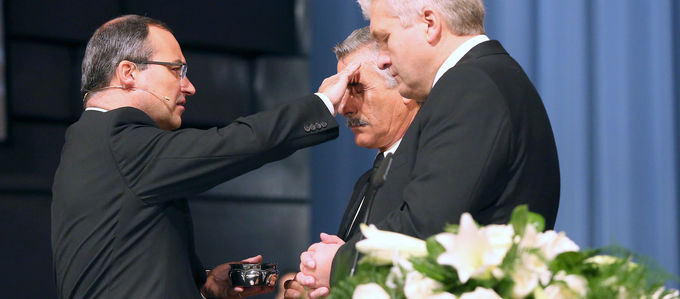
How does the believer receive the Holy Spirit? The Bible remains ambiguous and leaves quite a few gaps with respect to this question. Answers begin to develop of the early church. And this foundation stands to this day.
Signs—more signs are needed! Yes indeed, there is the baptism of water, the drowning of the old Adam, the washing of regeneration, immersion in the death of Jesus, the washing away of sins. But the Bible also talks about the Holy Spirit in the context of His seal and the act of anointing. And what would a disciple of the Christ (= Messiah = “Anointed One”) be without anointing?
This was more or less the line of reasoning in the early centuries after Christ, when a development began that was to have enduring implications.
From laying on of hands to anointing
The gift of the Holy Spirit must be imparted. So attests the gospel of John. So explains Paul, the author of so many epistles. And so demonstrates the laying on of hands in the book of Acts. Thus this gesture—together with the bath of water—has been part of the rite of baptism since New Testament times.
But the act of anointing came to be added soon after. And it has its biblical roots, for example, when Jesus applies the Messianic words of Isaiah to Himself: “The Spirit of the Lord is upon Me because He has anointed Me” (Luke 4: 18). Or when Peter preaches in the house of Cornelius about “how God anointed Jesus of Nazareth with the Holy Spirit” (Acts 10: 38).
More than just a decoration
Starting in the third century at the latest, the person being baptised would—after receiving the baptism of water—also receive the laying on of hands from the bishop, who would then also go on to anoint him with oil. This represented the culmination of a very extensive process incorporating several years of teaching as well as a number of days of preparation that included fasting, prayers, and other baths and anointings.
And already early on, this act of imparting the Spirit was seen not only as a decorative extension of the baptismal rites, but as a theological necessity. Without this confirmation, baptism was considered incomplete. The Church Father Cyprian already makes mention of this “double sacrament” in the middle of the third century.
The connection to the Apostle ministry
But differences emerge: while the episcopal laying on of hands was a central element in the Western Latin Church, the anointing was considered the more important aspect in the Eastern Greek Orthodox Church. And that was to play a decisive role in the question of which ministry would be allowed to perform this act. Either way, it was a question of how to connect this emerging new sacrament to the apostolic ministry.
In the West as in the East, ministerial authority was first thought to issue forth through “apostolic succession”—the uninterrupted sequence of ordinations of bishops by bishops all the way back to the time of the biblical Apostles. Because the laying on of hands is associated with the bishop, it is usually only a bishop who can perform confirmation in the Catholic Church. The Orthodox anointing, on the other hand, can also be performed by a priest. It is sufficient for a bishop to have consecrated the anointing oil.
Incorporation into a three-step programme
Just as in the early church, the Orthodox Churches welcome the believer with a tripartite celebration. Baptism with water is immediately followed by the act of Chrismation (an anointing with oil). This, in turn, is followed by Communion, the receiving of the Lord’s Supper—for both children and adults.
The anointing is performed with chrism, a sacred oil that is enriched with dozens of aromatic substances. In the sign of the cross, it is rubbed on the forehead, eyes, nose, mouth, ears, chest, hands, and feet of the believer. And each time, the priest speaks the words: “Seal of the gift of the Holy Spirit.”
While baptism allows the believer to participate in the death and resurrection of Christ, the act of Chrismation, according to Orthodox understanding, allows the believer to personally share in the delivery of the Holy Spirit at Pentecost. Through the act of anointing, the baptised person becomes a lay person—a member of the laós, the people of God.
The laying on of hands for imparting the gift of the Holy Spirit, the association of this act with the apostolic ministry and the image of the seal: the New Apostolic Church has inherited these aspects directly from early Christendom. In the next issue of this series we will explore the roots of this act’s status as an independent sacrament.
Photo: blobbotronic – stock.adobe.com














